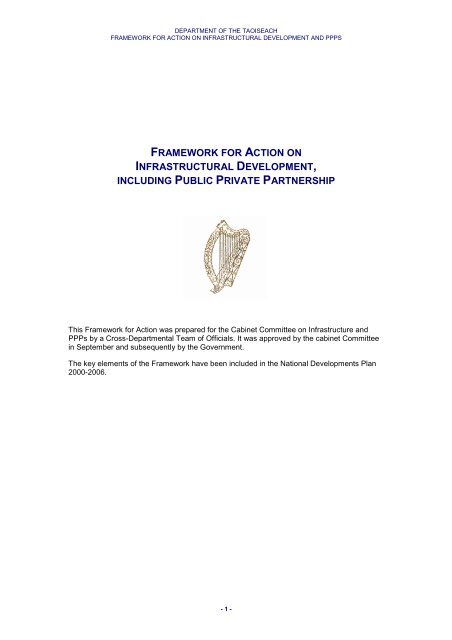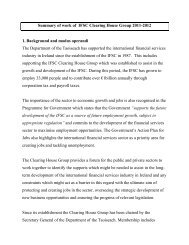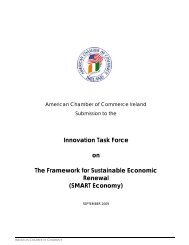Framework for Action on - Department of Taoiseach
Framework for Action on - Department of Taoiseach
Framework for Action on - Department of Taoiseach
You also want an ePaper? Increase the reach of your titles
YUMPU automatically turns print PDFs into web optimized ePapers that Google loves.
DEPARTMENT OF THE TAOISEACH<br />
FRAMEWORK FOR ACTION ON INFRASTRUCTURAL DEVELOPMENT AND PPPS<br />
FRAMEWORK FOR ACTION ON<br />
INFRASTRUCTURAL DEVELOPMENT,<br />
INCLUDING PUBLIC PRIVATE PARTNERSHIP<br />
This <str<strong>on</strong>g>Framework</str<strong>on</strong>g> <str<strong>on</strong>g>for</str<strong>on</strong>g> <str<strong>on</strong>g>Acti<strong>on</strong></str<strong>on</strong>g> was prepared <str<strong>on</strong>g>for</str<strong>on</strong>g> the Cabinet Committee <strong>on</strong> Infrastructure and<br />
PPPs by a Cross-<strong>Department</strong>al Team <strong>of</strong> Officials. It was approved by the cabinet Committee<br />
in September and subsequently by the Government.<br />
The key elements <strong>of</strong> the <str<strong>on</strong>g>Framework</str<strong>on</strong>g> have been included in the Nati<strong>on</strong>al Developments Plan<br />
2000-2006.<br />
- 1 -
DEPARTMENT OF THE TAOISEACH<br />
FRAMEWORK FOR ACTION ON INFRASTRUCTURAL DEVELOPMENT AND PPPS<br />
Key Recommendati<strong>on</strong>s<br />
(a) The core inter urban road infrastructure and Dublin transport package set out in paragraph<br />
7 and in Appendix I to be given top priority and <str<strong>on</strong>g>for</str<strong>on</strong>g>m an integral part <strong>of</strong> the NDP. Other<br />
outstanding transport and PPP decisi<strong>on</strong>s to be made by end <strong>of</strong> year.<br />
(b) The recommendati<strong>on</strong>s <str<strong>on</strong>g>for</str<strong>on</strong>g> improved programme and project delivery in appendices II and<br />
III to be endorsed by the Committee and implemented by the delivery agencies.<br />
(c) The PPP process to be resourced and accelerated<br />
(d) Larger scale road projects to be undertaken and c<strong>on</strong>structi<strong>on</strong> capacity to be increased,<br />
including through encouragement <strong>of</strong> internati<strong>on</strong>al competiti<strong>on</strong>.<br />
(e) The Planning Bill to be enacted by Easter 2000.<br />
(f) Rapid infrastructural development to be a key plank <strong>of</strong> any successor agreement to P2000.<br />
(g) A communicati<strong>on</strong>s strategy to be put in place at a number <strong>of</strong> levels to mobilise public<br />
support <str<strong>on</strong>g>for</str<strong>on</strong>g> the accelerated infrastructure programme.<br />
(h) The Cabinet Committee to meet <strong>on</strong> an <strong>on</strong>going basis with <strong>Department</strong>al <strong>of</strong>ficials and the<br />
Chief Executives <strong>of</strong> NRA and CIE to review progress <strong>on</strong> the key objectives at (a) above.<br />
(i) The team to prepare a scoping report by end <strong>of</strong> year <strong>on</strong> instituti<strong>on</strong>al, administrative, legal,<br />
communicati<strong>on</strong>s and other infrastructural issues. Possible improvements and alternatives to<br />
judicial review including the need <str<strong>on</strong>g>for</str<strong>on</strong>g> any c<strong>on</strong>stituti<strong>on</strong>al change to <str<strong>on</strong>g>for</str<strong>on</strong>g>m part <strong>of</strong> this report.<br />
Background<br />
1. The Government decisi<strong>on</strong> <strong>of</strong> 15 June 1999 established a Cabinet Committee <strong>on</strong><br />
Infrastructural Development, including Public Private Partnership, to be chaired by the<br />
<strong>Taoiseach</strong> and to include the Tánaiste, the Minister <str<strong>on</strong>g>for</str<strong>on</strong>g> Finance, the Minister <str<strong>on</strong>g>for</str<strong>on</strong>g> Public<br />
Enterprise, the Minister <str<strong>on</strong>g>for</str<strong>on</strong>g> the Envir<strong>on</strong>ment and Local Government and the Attorney General.<br />
2. The Government also decided that the secretariat to the Committee would be provided by a<br />
cross-departmental team, including the <strong>Department</strong>s <strong>of</strong> the <strong>Taoiseach</strong>; Enterprise; Trade and<br />
Employment; Finance; Envir<strong>on</strong>ment and Local Government; Public Enterprise and the<br />
Attorney General's Office: The terms <strong>of</strong> reference <strong>of</strong> the team are to develop and oversee<br />
implementati<strong>on</strong> <strong>of</strong> the framework <str<strong>on</strong>g>for</str<strong>on</strong>g> acti<strong>on</strong>, and in particular:<br />
a) deal with the planning approval issues to reduce the time taken, including<br />
by legislati<strong>on</strong> and/or c<strong>on</strong>stituti<strong>on</strong>al change,<br />
b) support the development and implementati<strong>on</strong> <strong>of</strong> the Public/Private<br />
Partnership framework, and<br />
c) support the <strong>on</strong>going work <strong>of</strong> the Cabinet Committee;<br />
3. The team were mandated to propose a framework <strong>of</strong> acti<strong>on</strong> to the Cabinet Committee, by<br />
mid-September, together with implementati<strong>on</strong> structures and timescale.<br />
4. The Cross <strong>Department</strong>al Team has met <strong>on</strong> 5 occasi<strong>on</strong>s and has agreed the framework <str<strong>on</strong>g>for</str<strong>on</strong>g><br />
acti<strong>on</strong> to be submitted to the Cabinet Committee. The framework is in 6 parts as follows:<br />
Secti<strong>on</strong> 1 identifies and seeks agreement to priority objectives<br />
Secti<strong>on</strong> 2 proposes a programme <strong>of</strong> acti<strong>on</strong> to support accelerati<strong>on</strong> <strong>of</strong> overall<br />
programme and individual project delivery<br />
- 2 -
DEPARTMENT OF THE TAOISEACH<br />
FRAMEWORK FOR ACTION ON INFRASTRUCTURAL DEVELOPMENT AND PPPS<br />
Secti<strong>on</strong> 3 addresses bottlenecks and c<strong>on</strong>straints, including capacity, skills<br />
and instituti<strong>on</strong>al barriers.<br />
Secti<strong>on</strong> 4 identifies the legal issues which need to be addressed.<br />
Secti<strong>on</strong> 5 makes recommendati<strong>on</strong>s in order to mobilise the widest possible<br />
support <str<strong>on</strong>g>for</str<strong>on</strong>g> the delivery <strong>of</strong> the planned investment programme.<br />
Secti<strong>on</strong> 6 sets out the proposed future work programme <strong>of</strong> the team and the<br />
Cabinet Committee <strong>on</strong> Infrastructural Development.<br />
Secti<strong>on</strong> 1 - Priority Objectives <str<strong>on</strong>g>for</str<strong>on</strong>g> <str<strong>on</strong>g>Acti<strong>on</strong></str<strong>on</strong>g><br />
5. In line with its terms <strong>of</strong> reference, the Team recommends that the initial focus <strong>of</strong> the<br />
Cabinet Committee's work should be <strong>on</strong> the timely delivery <strong>of</strong> the key transport infrastructure<br />
in the table at paragraph 7. In its c<strong>on</strong>siderati<strong>on</strong>, the Committee drew <strong>on</strong> the extensive work <strong>on</strong><br />
identifying transport infrastructure needs in respect <strong>of</strong> the NDP already carried out in the<br />
Nati<strong>on</strong>al Road Needs Study (NRA, 1998), the Review <strong>of</strong> Transport Infrastructure Investments<br />
Needs (DKM 1999) and the Dublin Transportati<strong>on</strong> Blueprint 2000-2006 (DTO-1999).<br />
6. Other areas <strong>of</strong> infrastructural investment such as housing supply, water and waste<br />
management and electricity supply are also <strong>of</strong> the highest importance. Many <strong>of</strong> the<br />
recommendati<strong>on</strong>s made in this report will also provide a model which can be applied to<br />
improve the delivery <strong>of</strong> n<strong>on</strong>-transport infrastructure projects. As part <strong>of</strong> its future work<br />
programme, the Team will review specific issues relevant to these other infrastructural areas<br />
including in particular electricity supply and the use <strong>of</strong> public private partnerships in waste<br />
water treatment facilities.<br />
Funding Arrangements<br />
7. In parts (i) and (ii) <strong>of</strong> the following list the Team have identified the key transport<br />
infrastructure which must put in place by 2006 if Ireland is not to suffer major c<strong>on</strong>straints <strong>on</strong><br />
its growth potential. In part (iii) the Team have identified the further transport infrastructure<br />
decisi<strong>on</strong>s which must be made by the end <strong>of</strong> 1999.<br />
The package <strong>of</strong> measures in the Table with the excepti<strong>on</strong> <strong>of</strong> the Eastern By-pass, which is to<br />
be the subject <strong>of</strong> further evaluati<strong>on</strong>, will be included in the NDP.<br />
- 3 -
DEPARTMENT OF THE TAOISEACH<br />
FRAMEWORK FOR ACTION ON INFRASTRUCTURAL DEVELOPMENT AND PPPS<br />
(i) The development <strong>of</strong> the following roads to motorway/high quality dual carriageway<br />
standard in their entirety by 2006:<br />
• Dublin to the Border<br />
• Galway to Dublin<br />
• Cork to Dublin<br />
• Limerick to Dublin<br />
• Water<str<strong>on</strong>g>for</str<strong>on</strong>g>d to Dublin (road type and route to be evaluated by end 1999)<br />
The service objective to be maintained into the <str<strong>on</strong>g>for</str<strong>on</strong>g>eseeable future will be a minimum inter<br />
urban speed <strong>of</strong> 60 mph <str<strong>on</strong>g>for</str<strong>on</strong>g> the entirety the above routes i.e. the standard associated with<br />
motorways.<br />
(ii) The implementati<strong>on</strong> <strong>of</strong> the following transport projects <str<strong>on</strong>g>for</str<strong>on</strong>g> the greater Dublin area:<br />
• Completi<strong>on</strong> <strong>of</strong> the M50 and the Port Access Tunnel.<br />
• Completi<strong>on</strong> <strong>of</strong> the LUAS Lines A and C (Tallaght to C<strong>on</strong>nolly) by end 2002 and B<br />
(Sandy<str<strong>on</strong>g>for</str<strong>on</strong>g>d to St Stephen's Green) by mid 2003. 1 & 2<br />
• Enhancement <strong>of</strong> the existing rail and bus services <strong>on</strong> the lines proposed in the<br />
DTO Transportati<strong>on</strong> Blueprint 2000-2006.<br />
• Implementati<strong>on</strong> <strong>of</strong> further traffic management and possible demand<br />
management strategies <strong>on</strong> the lines proposed in the DTO Blueprint.<br />
(iii) Urgent evaluati<strong>on</strong> should be completed so that decisi<strong>on</strong>s can be taken by end 1999<br />
as follows:<br />
- <strong>on</strong> the provisi<strong>on</strong> <strong>of</strong> an Eastern Motorway ( additi<strong>on</strong>al funding will need<br />
to be provided if this project proceeds).<br />
- <strong>on</strong> an indicative timetable <str<strong>on</strong>g>for</str<strong>on</strong>g> the implementati<strong>on</strong> <strong>of</strong> the St. Stephen's<br />
Green to Dublin Airport LUAS line (including underground secti<strong>on</strong>) 2<br />
- <strong>on</strong> the provisi<strong>on</strong> <strong>of</strong> new urban rail links (e.g. Dublin Airport, 2 Navan)<br />
following completi<strong>on</strong> <strong>of</strong> the necessary technical/feasibility studies.<br />
8. A detailed breakdown <strong>of</strong> the priority proposals is at Appendix I.<br />
Impact <strong>on</strong> Balanced Regi<strong>on</strong>al Development<br />
9. The adopti<strong>on</strong> <strong>of</strong> the programme above and its timely delivery is, in the team’s view<br />
essential if we are to ensure c<strong>on</strong>tinuing ec<strong>on</strong>omic growth and help to achieve balanced<br />
regi<strong>on</strong>al development. It is also important to emphasise that the priority infrastructure in<br />
paragraph 7 is <strong>on</strong>ly part <strong>of</strong> a much larger transport investment programme (including <str<strong>on</strong>g>for</str<strong>on</strong>g><br />
example the Western Corridor) which must be delivered in the period <strong>of</strong> the NDP. Significant<br />
other investment in infrastructure will be made in the Nati<strong>on</strong>al Development Plan to assist the<br />
Plan objective <strong>of</strong> balanced regi<strong>on</strong>al development. This investment will be provided in the<br />
c<strong>on</strong>text <strong>of</strong> a specific framework <str<strong>on</strong>g>for</str<strong>on</strong>g> Regi<strong>on</strong>al Development Policy to be articulated in the Plan.<br />
10. The priority transport infrastructure is, however, distinguishable by its particular<br />
importance to nati<strong>on</strong>al ec<strong>on</strong>omic development and to the development <strong>of</strong> the Greater Dublin<br />
area. Delay in providing it, would have substantial negative impacts throughout the country.<br />
- 4 -
DEPARTMENT OF THE TAOISEACH<br />
FRAMEWORK FOR ACTION ON INFRASTRUCTURAL DEVELOPMENT AND PPPS<br />
Secti<strong>on</strong> 2: Accelerati<strong>on</strong> <strong>of</strong> programme and project delivery<br />
11, Delivery by 2006 <strong>of</strong> the key objectives identified in Secti<strong>on</strong> 1, and <strong>of</strong> the overall ambitious<br />
infrastructure programme c<strong>on</strong>tained in the NDP, represents an enormous challenge. The<br />
scale <strong>of</strong> the challenge is exemplified by the fact that the indicative budget <str<strong>on</strong>g>for</str<strong>on</strong>g> nati<strong>on</strong>al roads<br />
<str<strong>on</strong>g>for</str<strong>on</strong>g> 2000-2006 is more than 3 times greater than <str<strong>on</strong>g>for</str<strong>on</strong>g> 1994-1999.<br />
12. To meet this challenge successfully, project planning will have to be intensified and<br />
accelerated, approval processes streamlined and the approach to project management<br />
sharpened. Private sector resources must also be drawn in as much as possible, through the<br />
PPP framework and otherwise, to increase delivery capacity <str<strong>on</strong>g>for</str<strong>on</strong>g> infrastructural programmes.<br />
(For example, NRA have estimated that the planning <strong>of</strong> nati<strong>on</strong>al road schemes at present<br />
absorbs annually some 120 pers<strong>on</strong> years <strong>of</strong> NRA input and some 200 pers<strong>on</strong> years <strong>of</strong><br />
c<strong>on</strong>sultancy input. The expanded NDP programme will require the NRA annual c<strong>on</strong>tributi<strong>on</strong> to<br />
be increased to at least 200 pers<strong>on</strong> years and the c<strong>on</strong>sultancy c<strong>on</strong>tributi<strong>on</strong> to be increased to<br />
1,000 pers<strong>on</strong> years).<br />
13. The Team have in the light <strong>of</strong> experience to date, set out in Appendix II recommendati<strong>on</strong>s<br />
<str<strong>on</strong>g>for</str<strong>on</strong>g> speedier programme delivery and in Appendix III "Best Practice Guidelines" <str<strong>on</strong>g>for</str<strong>on</strong>g> speedier<br />
project delivery. The Cabinet Committee should, in the Team's view, endorse these<br />
recommendati<strong>on</strong>s which will then be <str<strong>on</strong>g>for</str<strong>on</strong>g>warded to all relevant implementing agencies <str<strong>on</strong>g>for</str<strong>on</strong>g><br />
appropriate acti<strong>on</strong>. This will include not <strong>on</strong>ly the transport agencies, such as NRA and CIE,<br />
but all other infrastructural agencies including local authorities.<br />
14. The enhanced programme and project management envisaged by this report will help<br />
meet the greatly increased demands <strong>of</strong> the NDP transport infrastructure programme, and<br />
rectify internal weaknesses in project management and delivery capability which have been<br />
experienced in earlier programmes. However, the progress <strong>of</strong> transport infrastructure projects<br />
is also increasingly being threatened or delayed by external objecti<strong>on</strong>s and challenges: these<br />
can involve judicial reviews, the EU complaints procedure, the requirements <strong>of</strong> other public<br />
bodies or a combinati<strong>on</strong> <strong>of</strong> these factors. Improved project planning and management as<br />
proposed above will help to anticipate and overcome some <strong>of</strong> these threats. The legal and<br />
regulatory framework, which is to be developed (see secti<strong>on</strong> 4) will also help address these<br />
problems.<br />
15. The Team is aware that work <strong>on</strong> improving programme and project management is<br />
already underway. For example the Nati<strong>on</strong>al Roads Authority (NRA) has already<br />
strengthened its capacity by the creati<strong>on</strong> <strong>of</strong> new management posts including a PPP<br />
manager, and is c<strong>on</strong>ducting a further management review <strong>of</strong> the Road Safety/Transportati<strong>on</strong><br />
and Pavement and Materials Research Divisi<strong>on</strong>.<br />
16. In additi<strong>on</strong>, further proposals <str<strong>on</strong>g>for</str<strong>on</strong>g> strengthening the staffing <strong>of</strong> NRA Roads Programme<br />
Divisi<strong>on</strong>, including special arrangements designed to attract overseas based road engineers<br />
<strong>on</strong> c<strong>on</strong>tract are at an advanced stage <strong>of</strong> c<strong>on</strong>siderati<strong>on</strong>. The use <strong>of</strong> regi<strong>on</strong>al design teams,<br />
aggregated procurement <strong>of</strong> schemes and overlapping <strong>of</strong> stages is expected to reduce the<br />
normal planning/procurement period <str<strong>on</strong>g>for</str<strong>on</strong>g> a major roads project from 5 to 3½ years with the aim<br />
<strong>of</strong> just over 3 years as the new objective.<br />
- 5 -
DEPARTMENT OF THE TAOISEACH<br />
FRAMEWORK FOR ACTION ON INFRASTRUCTURAL DEVELOPMENT AND PPPS<br />
Secti<strong>on</strong> 3: Measures to address bottlenecks and c<strong>on</strong>straints including<br />
capacity, skills and instituti<strong>on</strong>al issues<br />
17. The Team recognise that the capacity <strong>of</strong> the c<strong>on</strong>structi<strong>on</strong> and ancillary sectors to fulfill the<br />
increased demand <str<strong>on</strong>g>for</str<strong>on</strong>g> infrastructural development will be critical to the achievement <strong>of</strong> the<br />
Nati<strong>on</strong>al Development Plan. The indigenous sector may not have, or be able to provide,<br />
adequate capacity to deliver the accelerated infrastructure programme proposed in the plan.<br />
There are also growing signs that capacity c<strong>on</strong>straints may be leading to above average price<br />
inflati<strong>on</strong> in the c<strong>on</strong>structi<strong>on</strong> area. Clearly if this trend is to c<strong>on</strong>tinue there would be adverse<br />
effects <str<strong>on</strong>g>for</str<strong>on</strong>g> the quantum <strong>of</strong> infrastructure delivered by the Nati<strong>on</strong>al Development Plan<br />
allocati<strong>on</strong>s. The Minister <str<strong>on</strong>g>for</str<strong>on</strong>g> the Envir<strong>on</strong>ment and Local Government has asked the Forum <str<strong>on</strong>g>for</str<strong>on</strong>g><br />
the C<strong>on</strong>structi<strong>on</strong> Industry to c<strong>on</strong>sider as a matter <strong>of</strong> urgency how capacity in the industry can<br />
be increased in order to ensure that this does not happen.<br />
18. The Team recommends that particular emphasis should be placed in this review <strong>on</strong> the<br />
availability <strong>of</strong> skilled pr<strong>of</strong>essi<strong>on</strong>al and technical pers<strong>on</strong>nel necessary to undertake the vastly<br />
increased planning and project management workload to implement an increased and<br />
accelerated infrastructural development programme.<br />
19. To complement this initiative, the Team recommends that the following programme to<br />
address these difficulties be put into operati<strong>on</strong> immediately:<br />
• Public Private Partnerships to be used:<br />
- to help increase capacity, particularly to supplement<br />
nati<strong>on</strong>al capacity with that from abroad,<br />
- to develop appropriate skills in Ireland both in the public<br />
and private sectors and<br />
- to obtain the benefits that such partnerships can bring not<br />
<strong>on</strong>ly in Design and Build but also in relati<strong>on</strong> to the<br />
Operati<strong>on</strong>al part <strong>of</strong> projects over their lifetime.<br />
• augment the overall capacity <strong>of</strong> the c<strong>on</strong>structi<strong>on</strong> industry, including through<br />
increasing the size <strong>of</strong> projects to stimulate the interest <strong>of</strong> <str<strong>on</strong>g>for</str<strong>on</strong>g>eign c<strong>on</strong>tractors<br />
• flexible and innovative pers<strong>on</strong>nel recruitment measures be used where necessary to<br />
augment the capacity <strong>of</strong> the implementing agencies.<br />
Public Private Partnerships<br />
20. PPP can play a significant role in enhancing capacity to deliver key projects, by<br />
harnessing private sector technical, financial and management skills as well as providing<br />
additi<strong>on</strong>al financial resources. Effective use <strong>of</strong> PPP requires implementati<strong>on</strong> agencies to<br />
adopt an innovative approach to the management <strong>of</strong> programmes as well as projects, such as<br />
identifying suitable classes <strong>of</strong> projects at an early stage and shifting their focus towards<br />
project outcomes and outputs. It is essential to take early decisi<strong>on</strong>s <strong>on</strong> approaches to PPP in<br />
the c<strong>on</strong>text <strong>of</strong> the accelerated programme. The pilot roads projects which are based <strong>on</strong> full or<br />
partial toll financing, are: (date planned to seek tenders)<br />
• Water<str<strong>on</strong>g>for</str<strong>on</strong>g>d By-pass, including a new bridge <strong>on</strong> the Suir, <strong>on</strong> the N25 (late 2000)<br />
• Sec<strong>on</strong>d West Link Bridge <strong>on</strong> the M50 (early 2000)<br />
• New Western River Crossing in Limerick <strong>on</strong> the N7 (mid 2001)<br />
It is also intended to actively explore the potential <str<strong>on</strong>g>for</str<strong>on</strong>g> a PPP to develop the Kilcock-Kinnegad<br />
secti<strong>on</strong> <strong>of</strong> the N4 (mid 2001)<br />
- 6 -
DEPARTMENT OF THE TAOISEACH<br />
FRAMEWORK FOR ACTION ON INFRASTRUCTURAL DEVELOPMENT AND PPPS<br />
In additi<strong>on</strong>, it is proposed to adopt a PPP approach to elements <strong>of</strong> the LUAS project.<br />
However, the Government will need to c<strong>on</strong>sider the appropriate approach to be adopted.<br />
Subject to the avoidance <strong>of</strong> undue delays, the transfer <strong>of</strong> planning risk should be c<strong>on</strong>sidered<br />
<str<strong>on</strong>g>for</str<strong>on</strong>g> <strong>on</strong>e <strong>of</strong> these pilot projects.<br />
21. It is important now to set targets <str<strong>on</strong>g>for</str<strong>on</strong>g> implementati<strong>on</strong> and in particular the means by which<br />
the estimated £1bn PPP element <strong>of</strong> the NDP nati<strong>on</strong>al roads expenditure is to be achieved.<br />
For example the use <strong>of</strong> mechanisms other than hard tolls need to be developed. The role <strong>of</strong><br />
PPP in helping acquire project management expertise also needs to be progressed urgently.<br />
Secti<strong>on</strong> 4: Legal Issues<br />
Planning issues<br />
22. As an indicati<strong>on</strong> <strong>of</strong> the importance that the Government accords to this issue the Team<br />
recommends that the Planning Bill should be given the highest priority in the legislative<br />
programme and be enacted be<str<strong>on</strong>g>for</str<strong>on</strong>g>e Easter 2000. The Bill c<strong>on</strong>tains a number <strong>of</strong> fundamental<br />
re<str<strong>on</strong>g>for</str<strong>on</strong>g>ms in relati<strong>on</strong> to the provisi<strong>on</strong> <strong>of</strong> public infrastructure. Chief am<strong>on</strong>g these is the transfer<br />
to An Bord Pleanala <strong>of</strong> the functi<strong>on</strong>s <strong>of</strong> the Minister <str<strong>on</strong>g>for</str<strong>on</strong>g> the Envir<strong>on</strong>ment and Local<br />
Government in relati<strong>on</strong> to the c<strong>on</strong>firmati<strong>on</strong> <strong>of</strong> Motorway Schemes/Compulsory Purchase<br />
Orders (CPOs) made by local authorities and the certificati<strong>on</strong>/approval <strong>of</strong> envir<strong>on</strong>mental<br />
impact statements in regard to major local authority developments e.g. motorways and water<br />
treatment plants.<br />
23. However, the Planning Bill amendments will address <strong>on</strong>ly improvements in the approval<br />
procedure <str<strong>on</strong>g>for</str<strong>on</strong>g> DOELG infrastructure projects. Other legislati<strong>on</strong> and administrative procedures<br />
which can apply to infrastructural developments including rail, c<strong>on</strong>servati<strong>on</strong>, marine licensing<br />
etc needs to be reviewed as a matter <strong>of</strong> urgency by the relevant <strong>Department</strong>s. The aim<br />
should be to eliminate unnecessary delays in the approval process. The Infrastructure<br />
Support Unit <strong>of</strong> the <strong>Department</strong> <strong>of</strong> Finance and the Regulatory Re<str<strong>on</strong>g>for</str<strong>on</strong>g>m Unit <strong>of</strong> the <strong>Department</strong><br />
<strong>of</strong> the <strong>Taoiseach</strong> will give this package <strong>of</strong> re<str<strong>on</strong>g>for</str<strong>on</strong>g>m the highest priority.<br />
Process <strong>of</strong> Judicial Review<br />
24. The Planning Bill c<strong>on</strong>tains a provisi<strong>on</strong> whereby those seeking Judicial Review will have to<br />
dem<strong>on</strong>strate a "substantial interest" in order to be successful in their applicati<strong>on</strong>. In its<br />
decisi<strong>on</strong> <strong>on</strong> the Planning Bill (S180/20/10/0193) <strong>of</strong> 21 July 1999 the Government authorised<br />
the Minister <str<strong>on</strong>g>for</str<strong>on</strong>g> Justice to take steps to ensure that judicial review <strong>of</strong> planning and<br />
infrastructural cases are dealt with speedily by the High Court, if necessary by setting up a<br />
special divisi<strong>on</strong> <strong>of</strong> the Court. The Team will examine the judicial review process<br />
(a) to ascertain whether Court Rules and procedures are<br />
unnecessarily delaying the resoluti<strong>on</strong> <strong>of</strong> legal challenges to<br />
infrastructural projects and<br />
(b) to ascertain whether the judicial review procedure is the<br />
most expeditious process <str<strong>on</strong>g>for</str<strong>on</strong>g> determining legal challenges to<br />
infrastructural projects.<br />
The team will also study the feasibility <strong>of</strong> having larger segments <strong>of</strong> infrastructure approved in<br />
<strong>on</strong>e procedure and methods <strong>of</strong> improving the approval procedures <str<strong>on</strong>g>for</str<strong>on</strong>g> projects so as to<br />
minimise the likelihood <strong>of</strong> judicial review proceedings being sought.<br />
25. The Team will also c<strong>on</strong>sider whether amendments to the C<strong>on</strong>stituti<strong>on</strong> are necessitated to<br />
protect the community interest in ensuring that infrastructual projects are completed speedily<br />
without unnecessary legal and other obstacles while preserving the rights <strong>of</strong> individuals under<br />
EC Law and under the European C<strong>on</strong>venti<strong>on</strong> <strong>of</strong> Human Rights.<br />
- 7 -
DEPARTMENT OF THE TAOISEACH<br />
FRAMEWORK FOR ACTION ON INFRASTRUCTURAL DEVELOPMENT AND PPPS<br />
Secti<strong>on</strong> 5: Mobilisati<strong>on</strong> <strong>of</strong> Public Support to implement the Infrastructure<br />
Programme<br />
26. The Nati<strong>on</strong>al Development Plan will involve an unprecedented expansi<strong>on</strong> and<br />
accelerati<strong>on</strong> <strong>of</strong> investment in infrastructure, particularly in the transport area. The completi<strong>on</strong><br />
<strong>of</strong> this programme is rightly seen as urgently required in the public interest by Government, by<br />
the social partners and by citizens. However, notwithstanding this important c<strong>on</strong>sensus, an<br />
expanded infrastructural programme <strong>on</strong> the scale now planned will inevitably give rise to<br />
objecti<strong>on</strong>s in relati<strong>on</strong> to the impact <strong>of</strong> individual projects. A widespread c<strong>on</strong>sensus in favour <strong>of</strong><br />
increased and accelerated infrastructural investment will not in itself translate into active<br />
support <str<strong>on</strong>g>for</str<strong>on</strong>g>, or an absence <strong>of</strong> objecti<strong>on</strong>s to, individual projects. One <strong>on</strong>ly needs to look to the<br />
examples <strong>of</strong> the Southern Cross motorway, Dublin Port Tunnel, LUAS and Quality Bus<br />
Corridors to see this reality.<br />
27. Experience indicates the importance <strong>of</strong> anticipating and managing the inevitable reacti<strong>on</strong><br />
from individuals, businesses and communities who are directly affected by the speed and<br />
scale <strong>of</strong> the building programme proposed. The Team are str<strong>on</strong>gly <strong>of</strong> the view that in planning<br />
and delivering the proposed accelerated infrastructural development programme in Ireland, it<br />
will be important to "champi<strong>on</strong>" the development in the nati<strong>on</strong>al c<strong>on</strong>text widely and in a very<br />
proactive way. For these reas<strong>on</strong>s, there is now a need to:<br />
(a) make even more effective the present wide c<strong>on</strong>sensus <strong>on</strong><br />
the priority <strong>of</strong> improving Irish infrastructure, particularly in the<br />
c<strong>on</strong>text <strong>of</strong> the Nati<strong>on</strong>al Development Plan<br />
(b) make the programme <strong>of</strong> infrastructural development and<br />
the objective <strong>of</strong> timely and efficient delivery <strong>of</strong> this<br />
programme an integral part <strong>of</strong> the Partnership process,<br />
particularly any successor agreement to Partnership 2000.<br />
(c) develop and implement a communicati<strong>on</strong>s strategy, at a<br />
number <strong>of</strong> levels, designed to in<str<strong>on</strong>g>for</str<strong>on</strong>g>m the public <strong>of</strong> the<br />
necessity <str<strong>on</strong>g>for</str<strong>on</strong>g> and the ec<strong>on</strong>omic and envir<strong>on</strong>mental benefits<br />
<strong>of</strong> infrastructural investment.<br />
28. In approaching this programme, a number <strong>of</strong> key messages need to be communicated<br />
clearly. In particular:<br />
• the rati<strong>on</strong>ale <str<strong>on</strong>g>for</str<strong>on</strong>g> the expenditure <strong>on</strong> infrastructure in terms <strong>of</strong> the safeguarding <strong>of</strong> the<br />
ec<strong>on</strong>omic and social progress made to date,<br />
• the benefits which society as a whole will derive from the quality <strong>of</strong> life improvements<br />
which improved accessibility and reduced c<strong>on</strong>gesti<strong>on</strong> will bring, and<br />
• the vital c<strong>on</strong>tributi<strong>on</strong> which effective infrastructure makes to securing future nati<strong>on</strong>al<br />
development and the safeguarding <strong>of</strong> the nati<strong>on</strong>al envir<strong>on</strong>ment.<br />
29. In view <strong>of</strong> the above, there is an urgent need to develop a coherent communicati<strong>on</strong>s<br />
strategy to get the message across about the advantages <strong>of</strong> rapid implementati<strong>on</strong> <strong>of</strong> the<br />
infrastructure programme (including envir<strong>on</strong>mental advantages). The damage both in terms <strong>of</strong><br />
ec<strong>on</strong>omic growth and quality <strong>of</strong> life which will result if there are major delays in the delivery <strong>of</strong><br />
infrastructure also need to be stressed. This strategy needs to operate not just at the central<br />
Government but also at local authority and semi-State levels. The strategy will have to be<br />
properly planned and resourced and will include the engagement <strong>of</strong> pr<strong>of</strong>essi<strong>on</strong>al assistance.<br />
The Team will now address this issue in more detail.<br />
- 8 -
DEPARTMENT OF THE TAOISEACH<br />
FRAMEWORK FOR ACTION ON INFRASTRUCTURAL DEVELOPMENT AND PPPS<br />
Secti<strong>on</strong> 6: Future Work Programme <strong>of</strong> the Team<br />
30. The Team is c<strong>on</strong>scious <strong>of</strong> a need to review possible wider instituti<strong>on</strong>al and administrative<br />
impediments to the effective implementati<strong>on</strong> <strong>of</strong> the transport investment programme proposed<br />
in the Nati<strong>on</strong>al Development Plan. In additi<strong>on</strong> to acting as a support Group <str<strong>on</strong>g>for</str<strong>on</strong>g> the Cabinet<br />
Sub-committee the Team there<str<strong>on</strong>g>for</str<strong>on</strong>g>e proposes, subject to the approval <strong>of</strong> the Committee, to<br />
prepare a scoping or where possible a more detailed strategy report by end December <strong>on</strong><br />
these issues, c<strong>on</strong>centrating <strong>on</strong>;<br />
• The instituti<strong>on</strong>al and administrative arrangements <str<strong>on</strong>g>for</str<strong>on</strong>g> the provisi<strong>on</strong> <strong>of</strong> public transport;<br />
• The administrative arrangements <str<strong>on</strong>g>for</str<strong>on</strong>g> the implementati<strong>on</strong> <strong>of</strong> nati<strong>on</strong>al road projects;<br />
• The instituti<strong>on</strong>al arrangements <str<strong>on</strong>g>for</str<strong>on</strong>g> transport in the greater Dublin area;<br />
• Examinati<strong>on</strong> <strong>of</strong> the judicial review process, and other opti<strong>on</strong>s <str<strong>on</strong>g>for</str<strong>on</strong>g> legal/c<strong>on</strong>stituti<strong>on</strong>al<br />
re<str<strong>on</strong>g>for</str<strong>on</strong>g>m as outlined in paragraphs 24 and 25;<br />
• The development and implementati<strong>on</strong> <strong>of</strong> a communicati<strong>on</strong>s strategy.<br />
• The removal <strong>of</strong> impediments to delivery <strong>of</strong> infrastructural projects in n<strong>on</strong> transport<br />
areas.<br />
31. As regards PPP, it is important that the good progress made to date and the momentum<br />
behind the PPP process be maintained and further developed. In line with its terms <strong>of</strong><br />
reference, the team will support the development and implementati<strong>on</strong> <strong>of</strong> the PPP framework.<br />
32. The secretariat <strong>of</strong> the Cabinet Committee will be based in the <strong>Department</strong> <strong>of</strong> the<br />
<strong>Taoiseach</strong>. In developing these reports the Team will be supported by the new Infrastructure<br />
Unit in the <strong>Department</strong> <strong>of</strong> Finance and the Head <strong>of</strong> that Unit will participate in future meetings<br />
<strong>of</strong> the Team.<br />
Work <strong>of</strong> the Cabinet Committee <strong>on</strong> Infrastructure and Public Private Partnerships<br />
33. The Team recommends that the Cabinet Committee:<br />
• Approve the priority objectives and projects set out in Secti<strong>on</strong> 1.<br />
• Approve the recommendati<strong>on</strong>s <str<strong>on</strong>g>for</str<strong>on</strong>g> acti<strong>on</strong> in relati<strong>on</strong> to programme and project<br />
delivery in Secti<strong>on</strong>s 2 and 3 (and Appendices II and III) and mandate the Team to<br />
liaise <strong>on</strong> the implementati<strong>on</strong> <strong>of</strong> these recommendati<strong>on</strong>s with the delivery agencies.<br />
• Approve the future work programme <strong>of</strong> the team outlined in this Secti<strong>on</strong>.<br />
• Adopt the role <strong>of</strong> promoting the infrastructural development programme outlined in<br />
Secti<strong>on</strong> 5.<br />
34. It is recommended that the Cabinet Committee meet with the Secretaries General <strong>of</strong> the<br />
<strong>Department</strong>s <strong>of</strong> Envir<strong>on</strong>ment and Local Government, Finance, Public Enterprise and the<br />
Chief Executives <strong>of</strong> the NRA and CIE <strong>on</strong> a regular basis to m<strong>on</strong>itor progress <strong>on</strong> the priority<br />
projects. From time to time, it will also be necessary to include other <strong>Department</strong>s with<br />
licensing/c<strong>on</strong>trol functi<strong>on</strong>s e.g. <strong>Department</strong> <strong>of</strong> the Marine and Natural Resources in relati<strong>on</strong> to<br />
marine <str<strong>on</strong>g>for</str<strong>on</strong>g>eshore licensing, the <strong>Department</strong> <strong>of</strong> Arts, Heritage, Gaeltacht and the Islands in<br />
relati<strong>on</strong> to heritage, habits and archaeological functi<strong>on</strong>s which impact <strong>on</strong> infrastructure<br />
development .<br />
35. The resp<strong>on</strong>se <strong>of</strong> these bodies to the recommendati<strong>on</strong>s <strong>on</strong> project and programme<br />
management outlined in Secti<strong>on</strong> 2 should <str<strong>on</strong>g>for</str<strong>on</strong>g>m the basis <str<strong>on</strong>g>for</str<strong>on</strong>g> the initial interacti<strong>on</strong> between<br />
each <strong>of</strong> these bodies and the Cabinet Committee.<br />
- 9 -
DEPARTMENT OF THE TAOISEACH<br />
FRAMEWORK FOR ACTION ON INFRASTRUCTURAL DEVELOPMENT AND PPPS<br />
In additi<strong>on</strong>, a more detailed timetable should be prepared <str<strong>on</strong>g>for</str<strong>on</strong>g> each project identified in<br />
Appendix I, giving a completi<strong>on</strong> date <str<strong>on</strong>g>for</str<strong>on</strong>g> each major phase in project planning, approval and<br />
implementati<strong>on</strong>. The LUAS indicative timetable published by the Minister <str<strong>on</strong>g>for</str<strong>on</strong>g> Public Enterprise<br />
in May 1998 has proven useful in this regard.<br />
36. A table <strong>of</strong> these key infrastructural projects should be prepared <str<strong>on</strong>g>for</str<strong>on</strong>g> each meeting giving<br />
the current state <strong>of</strong> progress against the indicative timetable and budget and identifying risk<br />
factors. Each meeting should commence with a report <strong>on</strong> progress to date, including the<br />
cause <strong>of</strong> delays and cost overruns, if any, and possible soluti<strong>on</strong>s.<br />
- 10 -
DEPARTMENT OF THE TAOISEACH<br />
FRAMEWORK FOR ACTION ON INFRASTRUCTURAL DEVELOPMENT AND PPPS<br />
Cross <strong>Department</strong>al Team <strong>on</strong> Infrastructural Development<br />
and Public Private Partnership<br />
September 1999<br />
APPENDIX I<br />
Key Transport Projects 2000-2006<br />
(I) Nati<strong>on</strong>al Roads<br />
This programme adopts the policy objective <strong>of</strong> providing a high quality <strong>of</strong> service <strong>on</strong> the<br />
strategic routes and <strong>of</strong> completing/substantially completing these routes by 2006 3 . All roads<br />
are to be built to motorway/high quality dual carriageway standard and a minimum level <strong>of</strong><br />
service C (equivalent to minimum 60mph average interurban speed) would obtain from<br />
c<strong>on</strong>structi<strong>on</strong> time through to 2019 <strong>on</strong> these routes; higher levels <strong>of</strong> service would in practice<br />
be comm<strong>on</strong>ly achieved.<br />
Project Commencement Completi<strong>on</strong><br />
M50 to Border<br />
M1 Cloghran/Lissenhall 2000 2002<br />
M1 Lissenhall/Balbriggan 2001 2003<br />
M1 Drogheda By-Pass 1999 2002<br />
M1 Dunleer/Dundalk 1998 2001<br />
M1 Dundalk Western By-Pass 2001 2003<br />
N1 Border/Dundalk 2003 2005<br />
Dublin-Galway<br />
N4 Leixlip/M50 Juncti<strong>on</strong> 2001 2003<br />
N4 Celbridge Interchange 2000 2001<br />
N4 Kinnegad-Enfield By-Pass 4 2002 2005<br />
N6 Kinnegad/Athl<strong>on</strong>e 2003 2006<br />
N6 Loughrea/Athl<strong>on</strong>e 2004 2006<br />
N6 Loughrea By-Pass 2001 2002<br />
N6 Oranmore/Loughrea 2003 2005<br />
Dublin-Limerick<br />
N7 Naas Road to Kildare Co.<br />
Boundary<br />
2001 2003<br />
N7 Naas Road Widening 2002 2004<br />
N7 Kildare By-Pass 1998 2002<br />
- 11 -
DEPARTMENT OF THE TAOISEACH<br />
FRAMEWORK FOR ACTION ON INFRASTRUCTURAL DEVELOPMENT AND PPPS<br />
N7 M<strong>on</strong>asterevan By-Pass 2001 2003<br />
N7 Portlaoise/Mountrath By-Pass 2003 2005<br />
N7 Mountrath/Nenagh 2004 2006<br />
N7 Nenagh By-Pass 1998 2000<br />
N7 Nenagh/Limerick 2002 2005<br />
N7 Limerick Southern Ring Road<br />
Ph 1<br />
1999 2002<br />
N7 Limerick Southern Ring Road<br />
Ph 2<br />
2002 2004<br />
Dublin-Cork<br />
N8 Portlaoise/Durrow By-Pass 2003 2005<br />
N8 Durrow/Horse & Jockey 2003 2006<br />
Project Commencement Completi<strong>on</strong><br />
N8 Horse & Jockey/Caher By-Pass 2002 2006<br />
N8 Mitchelstown/Caher 2004 2006<br />
N8 Mitchelstown By-<br />
Pass/Rathcormack<br />
2003 2006<br />
N8 Fermoy By-Pass 2002 2004<br />
N8 Watergrasshill By-Pass 2000 2002<br />
M50<br />
M50 Dublin Port Tunnel 2000 2003<br />
M50 Southern Cross Route 1998 2001<br />
M50 South Eastern Motorway 2000 2003<br />
M50 Sec<strong>on</strong>d West Link Bridge 2000 2002<br />
M50 Upgrading (3 lanes and<br />
interchanges)<br />
2002 2005<br />
M50 Eastern Motorway [subject to<br />
NRA evaluati<strong>on</strong>]<br />
2003 2006<br />
- 12 -
DEPARTMENT OF THE TAOISEACH<br />
FRAMEWORK FOR ACTION ON INFRASTRUCTURAL DEVELOPMENT AND PPPS<br />
(ii) Public Transport<br />
Mode Project Indicative Completi<strong>on</strong> Timetable<br />
LUAS<br />
Lines A and C (Tallaght to end 2002<br />
C<strong>on</strong>nolly Stati<strong>on</strong>)<br />
Line B (Sandy<str<strong>on</strong>g>for</str<strong>on</strong>g>d to St. Stephens<br />
Green)<br />
Lines D and E (St.Stephens Green<br />
to Dublin Airport)<br />
Bus Project Additi<strong>on</strong>al bus capacity (275<br />
buses)<br />
Local Bus Networks (11 locati<strong>on</strong>s,<br />
80 buses)<br />
Rail Project<br />
mid 2003<br />
decide indicative timetable by end<br />
1999<br />
phased provisi<strong>on</strong> 2000-2006<br />
Phase 1 (7 locati<strong>on</strong>s): end 2000<br />
Phase 2 (4 locati<strong>on</strong>s): end 2003<br />
5 New Quality Bus Corridors Phased provisi<strong>on</strong> to 2006<br />
Additi<strong>on</strong>al DART rolling stock (46<br />
cars)<br />
16 by end 2002,<br />
30 by end 2006<br />
Additi<strong>on</strong>al Diesel Railcars (58) phased provisi<strong>on</strong> to 2006<br />
Upgrade Greyst<strong>on</strong>es to Arklow line end 2001<br />
Resignal and upgrade Howth to<br />
Barrow Street<br />
Upgrade Kildare to C<strong>on</strong>nolly line<br />
(including Phoenix Park tunnel)<br />
New stati<strong>on</strong>s and l<strong>on</strong>ger plat<str<strong>on</strong>g>for</str<strong>on</strong>g>ms<br />
at existing stati<strong>on</strong>s<br />
Suburban rail development<br />
programme (Dublin Airport, Navan,<br />
etc.)<br />
Integrati<strong>on</strong> Park & Ride (8 sites, 3,700<br />
spaces)<br />
Public transport interchange (19<br />
locati<strong>on</strong>s)<br />
to be decided in c<strong>on</strong>text <strong>of</strong><br />
c<strong>on</strong>sultants report<br />
end 2002<br />
Integrated ticketing and fares end 2002<br />
phased provisi<strong>on</strong> to end 2003<br />
projects and indicative timetable by<br />
end 1999<br />
phased provisi<strong>on</strong> to 2005<br />
phased provisi<strong>on</strong> to end 2002<br />
The Implementati<strong>on</strong> <strong>of</strong> transport infrastructure projects in the greater Dublin Area will need to<br />
be accompanied by a demand management strategy, the details <strong>of</strong> which will be developed<br />
by the Dublin Transportati<strong>on</strong> Office.<br />
All new buses, railcars, light rail vehicles and stati<strong>on</strong>s provided under the public transport<br />
programme <str<strong>on</strong>g>for</str<strong>on</strong>g> the Greater Dublin Area will be accessible to mobility impaired and disabled<br />
people.<br />
- 13 -
DEPARTMENT OF THE TAOISEACH<br />
FRAMEWORK FOR ACTION ON INFRASTRUCTURAL DEVELOPMENT AND PPPS<br />
APPENDIX II<br />
Recommendati<strong>on</strong>s <strong>on</strong> Accelerated and Expanded Infrastructure Programme delivery<br />
• Implementing agencies should urgently assess their organisati<strong>on</strong>al requirements in<br />
relati<strong>on</strong> to expanded/accelerated programmes and complete any necessary<br />
strengthening/reallocati<strong>on</strong> <strong>of</strong> resources as quickly as possible.<br />
• Involvement <strong>of</strong> c<strong>on</strong>sultants should be maximised from an early stage <strong>of</strong> project<br />
panning so as to allow overall programme delivery to be speeded up.<br />
• Both at planning and c<strong>on</strong>structi<strong>on</strong> stages (subject to separate requirements) the<br />
possibilities <str<strong>on</strong>g>for</str<strong>on</strong>g> aggregating projects should be maximised with a view to achieving<br />
ec<strong>on</strong>omies <strong>of</strong> scale.<br />
• At this stage and in the early years <strong>of</strong> NDP, it is vital to prioritise, and significantly to<br />
increase investment in, the planning <strong>of</strong> new projects.<br />
• Use <strong>of</strong> PPP should be c<strong>on</strong>sidered where it has potential to assist in the early delivery<br />
<strong>of</strong> infrastructure projects and can provide value <str<strong>on</strong>g>for</str<strong>on</strong>g> m<strong>on</strong>ey <str<strong>on</strong>g>for</str<strong>on</strong>g> the public sector over<br />
the lifetime <strong>of</strong> the project.<br />
- 14 -
DEPARTMENT OF THE TAOISEACH<br />
FRAMEWORK FOR ACTION ON INFRASTRUCTURAL DEVELOPMENT AND PPPS<br />
APPENDIX III<br />
Delivering the Infrastructure Provisi<strong>on</strong>s <strong>of</strong> the Nati<strong>on</strong>al Development<br />
Plan<br />
2000 - 2006<br />
BEST PRACTICE GUIDELINES FOR PROJECT IMPLEMENTATION<br />
Introducti<strong>on</strong><br />
The following "Best Practice" guidelines were drafted as part <strong>of</strong> the <str<strong>on</strong>g>Framework</str<strong>on</strong>g> <str<strong>on</strong>g>for</str<strong>on</strong>g> <str<strong>on</strong>g>Acti<strong>on</strong></str<strong>on</strong>g> <strong>on</strong><br />
Infrastructural Development, including Public Private Partnerships which has been approved<br />
by the Government. They provide a framework <str<strong>on</strong>g>for</str<strong>on</strong>g> the implementati<strong>on</strong> <strong>of</strong> project management<br />
to the best available standards across all sectors and projects. They are intended to act as an<br />
overall statement <strong>of</strong> best practice and to build <strong>on</strong> and complement the existing good practice<br />
in operati<strong>on</strong>.<br />
The Guidelines are intended to ensure c<strong>on</strong>sistency in project management in relati<strong>on</strong> to<br />
infrastructure delivery and <str<strong>on</strong>g>for</str<strong>on</strong>g> this reas<strong>on</strong>, they focus specifically <strong>on</strong> project management<br />
techniques in each phase <strong>of</strong> the project. They are not a full statement <strong>of</strong> the duties <strong>of</strong> project<br />
managers and, in particular, it is assumed that health and safety standards and good<br />
industrial relati<strong>on</strong>s practices which fully comply with all statutory and other obligati<strong>on</strong>s will be<br />
applied.<br />
General<br />
The accelerated level <strong>of</strong> infrastructural investment provided <str<strong>on</strong>g>for</str<strong>on</strong>g> in then Nati<strong>on</strong>al Development<br />
Plan will place increasing demands <strong>on</strong> implementing agencies. The financial allocati<strong>on</strong>s <str<strong>on</strong>g>for</str<strong>on</strong>g><br />
projects will take account <strong>of</strong> this factor. The need to remain within the financial parameters<br />
<str<strong>on</strong>g>for</str<strong>on</strong>g> the project should be kept clearly in view. All implementing and other agencies<br />
should c<strong>on</strong>tinually review the deployment <strong>of</strong> resources to ensure maximum possible<br />
effectiveness. The opti<strong>on</strong> <strong>of</strong> pooling resources between implementing agencies where<br />
appropriate should also be pursued.<br />
Quality management should <str<strong>on</strong>g>for</str<strong>on</strong>g>m an integral part <strong>of</strong> the project management process.<br />
The relevant agency should be in a positi<strong>on</strong> to show that all due processes have been<br />
complied with. The quality management process should also cover the approvals and<br />
decisi<strong>on</strong> procedures within each agency or authority which has licensing, decisi<strong>on</strong> or approval<br />
powers in respect <strong>of</strong> the project.<br />
Preparatory Phase Recommendati<strong>on</strong>s<br />
C<strong>on</strong>siderati<strong>on</strong> <strong>of</strong> each project should take account <strong>of</strong> the Guidelines <str<strong>on</strong>g>for</str<strong>on</strong>g> the Appraisal and<br />
Management <strong>of</strong> Capital Expenditure Proposals in the Public Sector which were issued by<br />
the <strong>Department</strong> <strong>of</strong> Finance in July 1994 and the Working Rules <str<strong>on</strong>g>for</str<strong>on</strong>g> Cost-Benefit Analysis<br />
published by the CSF Evaluati<strong>on</strong> Unit <strong>of</strong> the <strong>Department</strong> <strong>of</strong> Finance.<br />
For each project, or an appropriate grouping <strong>of</strong> projects, the implementing agency should<br />
establish a dedicated project planning team with an experienced full time project<br />
manager and adequate pers<strong>on</strong>nel with relevant skills, expertise and experience. Project<br />
teams can comprise agency staff or c<strong>on</strong>sultants or a combinati<strong>on</strong> <strong>of</strong> both. The need <str<strong>on</strong>g>for</str<strong>on</strong>g><br />
adequate public relati<strong>on</strong>s and legal expertise is particularly important.<br />
- 15 -
DEPARTMENT OF THE TAOISEACH<br />
FRAMEWORK FOR ACTION ON INFRASTRUCTURAL DEVELOPMENT AND PPPS<br />
The most appropriate size <strong>of</strong> the project needs to be clearly defined. Larger projects may<br />
be more appropriate in a PPP c<strong>on</strong>text. However, it is also important that the size <strong>of</strong> the project<br />
is defined by reference to its complexity. If a project is too big and too complex this may<br />
add to delay.<br />
The implementing agency and funding body should establish clear and effective decisi<strong>on</strong><br />
making structures from the incepti<strong>on</strong> <strong>of</strong> project planning right through to the completi<strong>on</strong> <strong>of</strong><br />
c<strong>on</strong>structi<strong>on</strong>. The m<strong>on</strong>itoring and oversight arrangements required by <strong>Department</strong>s should be<br />
critically reviewed so as to ensure that they are the absolute minimum necessary and that<br />
they do not unnecessarily divert planning resources or duplicate other m<strong>on</strong>itoring<br />
arrangements.<br />
Implementing agencies, and funding bodies, should ensure that adequate financial<br />
resources are allocated each year to the planning <strong>of</strong> infrastructure projects and<br />
prioritised to avoid wasting resources <strong>on</strong> projects which may not eventually proceed.<br />
Each project should have an adequate and clearly defined budget, with an adequate<br />
c<strong>on</strong>tingency provisi<strong>on</strong>. It is essential that there is sufficient budgetary flexibility within overall<br />
agreed allocati<strong>on</strong>s to ensure that essential modificati<strong>on</strong>s arising from the public c<strong>on</strong>sultati<strong>on</strong><br />
or envir<strong>on</strong>mental impact assessment process can be taken <strong>on</strong> board. Adequate cost c<strong>on</strong>trol<br />
procedures should be in place to ensure that changes are not taken as an invitati<strong>on</strong> to<br />
escalate project costs but as a prudent measure to address c<strong>on</strong>cerns be<str<strong>on</strong>g>for</str<strong>on</strong>g>e they become a<br />
major delaying factor during the approval process.<br />
Each project should have a clearly defined set <strong>of</strong> indicators to enable cost comparis<strong>on</strong><br />
across projects and to enable the measurement <strong>of</strong> progress <strong>on</strong> the project during its<br />
executi<strong>on</strong>.<br />
Public c<strong>on</strong>sultati<strong>on</strong> should be thorough and well managed. It should be approached with<br />
an open mind and a preparedness to modify the project where appropriate. It should be well<br />
resourced with skilled pers<strong>on</strong>nel who can address the issues raised. It should be focused and<br />
work within a tightly defined timetable.<br />
Public advocacy <strong>of</strong> individual projects needs to be properly resourced, well prepared<br />
and effectively managed by the implementing agency. It is vitally important that the purpose<br />
<strong>of</strong> the proposed project be clearly explained to the general public and opini<strong>on</strong> <str<strong>on</strong>g>for</str<strong>on</strong>g>mers and<br />
that objecti<strong>on</strong>s to the project and c<strong>on</strong>cerns about it are quickly and effectively addressed. In<br />
certain cases, it may be appropriate to appoint a project champi<strong>on</strong> who will be the public face<br />
<strong>of</strong> the project. Well planned engagement with n<strong>on</strong>-governmental organisati<strong>on</strong>s, particularly<br />
those with roles laid down in legislati<strong>on</strong>, should <str<strong>on</strong>g>for</str<strong>on</strong>g>m an integral part <strong>of</strong> the management <strong>of</strong><br />
the project.<br />
Each major project should have a thorough envir<strong>on</strong>mental assessment which identifies<br />
and addresses all significant impacts <strong>on</strong> the envir<strong>on</strong>ment. There should be full cooperati<strong>on</strong><br />
between the relevant envir<strong>on</strong>mental agencies and the project team to ensure that<br />
potential impacts are identified as early as possible in the planning process <str<strong>on</strong>g>for</str<strong>on</strong>g> the project.<br />
Envir<strong>on</strong>mental agencies should ensure that they provide sufficient resources to do this.<br />
Where additi<strong>on</strong>al resources are required <str<strong>on</strong>g>for</str<strong>on</strong>g> this purpose, reas<strong>on</strong>able, appropriate and<br />
properly documented costs can be charged to the project.<br />
Similarly, implementing agencies should co-operate fully with statutory agencies and utilities<br />
to identify and address issues as early as possible in the planning process. Adequate<br />
resources with overall agreed allocati<strong>on</strong>s should be allocated to ensure this and reas<strong>on</strong>able,<br />
appropriate and properly documented additi<strong>on</strong>al costs incurred by the agencies or utilities can<br />
be charged to the projects.<br />
It may be appropriate to establish a utilities group to co-ordinate the approach to utilities <strong>on</strong><br />
certain major projects. Clear criteria should be developed as to the costing and charging <strong>of</strong><br />
utilities works and clear rules should be established in relati<strong>on</strong> to allocati<strong>on</strong> <strong>of</strong> costs arising<br />
from the betterment <strong>of</strong> utilities.<br />
- 16 -
DEPARTMENT OF THE TAOISEACH<br />
FRAMEWORK FOR ACTION ON INFRASTRUCTURAL DEVELOPMENT AND PPPS<br />
Approval Phase Recommendati<strong>on</strong>s<br />
The implementing agency should allocate adequate and appropriately skilled resources to<br />
the preparati<strong>on</strong> and presentati<strong>on</strong> <strong>of</strong> its case <str<strong>on</strong>g>for</str<strong>on</strong>g> statutory approval. The documentati<strong>on</strong><br />
supporting the applicati<strong>on</strong> needs to be <strong>of</strong> high quality, adequately set out the case <str<strong>on</strong>g>for</str<strong>on</strong>g> the<br />
project and properly address the likely envir<strong>on</strong>mental impact. The technical and legal team<br />
presenting the case <str<strong>on</strong>g>for</str<strong>on</strong>g> the project need to be adequately resourced and well prepared and<br />
briefed.<br />
An Bord Pleanala should ensure that the inspector appointed to c<strong>on</strong>duct an inquiry or<br />
hearing into a major project is, wherever possible, assigned <strong>on</strong> a full-time basis until<br />
his/her work is completed. The Bord should ensure that it has adequate legal resources to<br />
prepare the necessary legal documentati<strong>on</strong> arising from its decisi<strong>on</strong>s, which in some cases<br />
will be significantly different to that used <str<strong>on</strong>g>for</str<strong>on</strong>g> planning appeal decisi<strong>on</strong>s.<br />
Implementing agencies and An Bord Pleanala should establish dedicated legal /<br />
administrative teams to manage legal acti<strong>on</strong>s in respect <strong>of</strong> infrastructural projects in a<br />
proactive manner. Such cases must be pursued by the public authorities in a much more<br />
focused and proactive way than has been the practice to date, with a particular emphasis <strong>on</strong><br />
compliance with timetables set by the Rules <strong>of</strong> the Superior Courts or in Court Orders.<br />
Implementati<strong>on</strong> Phase Recommendati<strong>on</strong>s<br />
Implementing agencies must ensure, as far as possible, that a project is ready to<br />
proceed immediately the necessary statutory approval comes into <str<strong>on</strong>g>for</str<strong>on</strong>g>ce. This will<br />
involve thecompleti<strong>on</strong> <strong>of</strong> designs and the preparati<strong>on</strong> <strong>of</strong> c<strong>on</strong>tract documents in parallel with<br />
the approval process. It will also require the project team to attempt to anticipate the<br />
c<strong>on</strong>diti<strong>on</strong>s to be attached to the approval, having regard to the evidence heard at the inquiry<br />
or hearing. Such an approach involves a risk that some <strong>of</strong> the work d<strong>on</strong>e may subsequently<br />
have to be modified or set aside. However, the balance <strong>of</strong> advantage normally favours taking<br />
this risk.<br />
At an early stage in the planning <strong>of</strong> major projects, the project planning team should<br />
undertake a risk assessment to decide <strong>on</strong> the appropriate level <strong>of</strong> investigati<strong>on</strong> <strong>of</strong><br />
geological and ground c<strong>on</strong>diti<strong>on</strong>s and other technical factors which might delay the<br />
c<strong>on</strong>structi<strong>on</strong> process. The earliest possible c<strong>on</strong>sultati<strong>on</strong> <strong>of</strong> the state agencies resp<strong>on</strong>sible <str<strong>on</strong>g>for</str<strong>on</strong>g><br />
envir<strong>on</strong>mental and heritage protecti<strong>on</strong> should be ensured.<br />
A public private partnership approach should be adopted wherever it will accelerate<br />
the implementati<strong>on</strong> <strong>of</strong> a particular project and represent better value <str<strong>on</strong>g>for</str<strong>on</strong>g> m<strong>on</strong>ey over<br />
the full life cycle <strong>of</strong> the project. The most appropriate <str<strong>on</strong>g>for</str<strong>on</strong>g>m <strong>of</strong> PPP (ranging from design and<br />
build to design, build, finance and operate) should be adopted having regard to the particular<br />
circumstances <strong>of</strong> the individual project.<br />
The Cross <strong>Department</strong>al Team <strong>on</strong> Infrastructural Development and Public Private Partnerships.<br />
<strong>Department</strong> <strong>of</strong> the <strong>Taoiseach</strong><br />
February 2000<br />
- 17 -
















